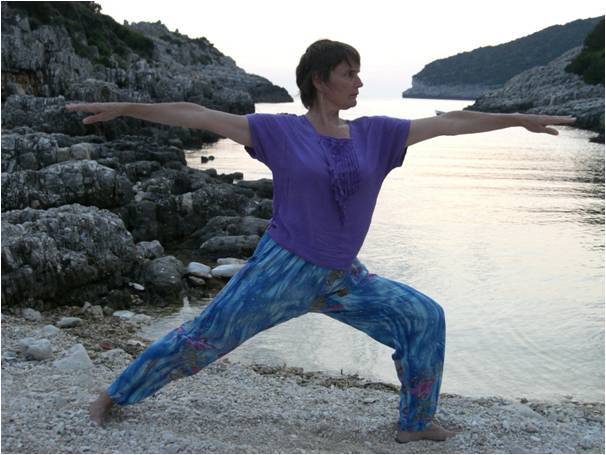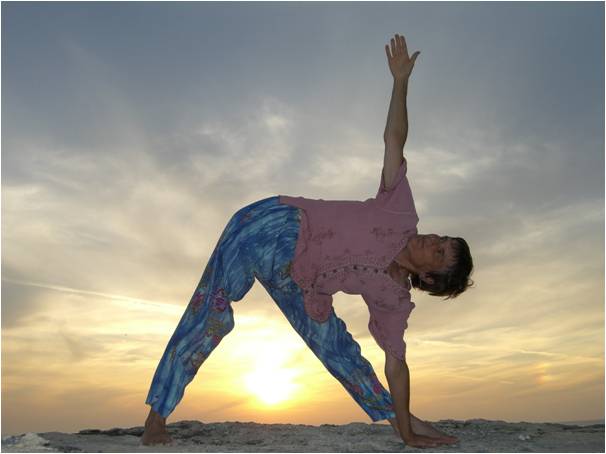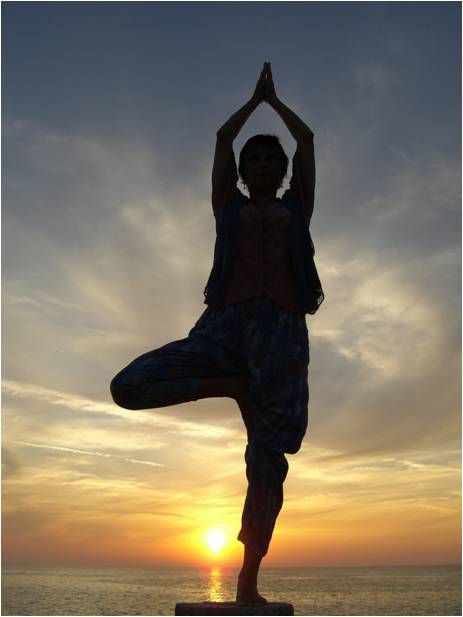What is yoga?
Yoga is simultaneously: self-diagnosis, healing, prevention, and maintenance.

The majority of yoga classes in the west cover Hatha yoga. Hatha yoga sessions include: asanas (physical postures), breathing practices, concentration, balance and meditation.
Yoga originates from India and the asanas, the physical yoga postures, are ancient tried-and-tested exercises, developed in India over thousands of years. They help improve general well being, flexibility, balance, breathing, memory, co-ordination, concentration and self-awareness; they also help focus and quieten the mind.
The asanas have taken their present form over centuries of practice through trial and error to its present day fine tuning. They help to open, clear and alter the subtle energies of the body, encouraging the flow of energy, building general energy levels (prana/chi). The muscles are trained to stretch and lengthen out of their usual tense, shortened holding patterns, allowing weaker areas to strengthen and the whole body to align and balance out.
The asana yoga practice has the effect of a body massage, not just working on the muscles, but also on the deeper tissues and all the internal organs, improving the flow of blood, cerebrospinal fluid circulation and lymphatic drainage, helping digestion and elimination.
Asana postures are what people in the west associate yoga with, but yoga practice consists of ‘eight limbs’. They are branches to be explored, several at a time, and aimed towards spiritual growth. From a relatively simple beginning using the asanas, yoga can lead you on to higher concepts. The first five limbs are known as the outer limbs. Limbs one and two are codes of moral conduct and limbs three, four and five involve the interpretation of the mind, body and spirit. The last three limbs, the inner limbs, are states of mind.
Yoga practice helps to harmonise mind, body and spirit, it becomes a state of being. Yoga teaches us concentration, to quieten the mind and observe ‘being in the now’. It teaches us patience and humbleness as we overcome the challenges that learning and progressing in yoga offers us. It opens and expands our heart, giving us a sense of wholeness and peace.
I have now retired from teaching yoga professionally, focussing fully my on tai chi and qigong practice, but have left the information on yoga as general information for visitors to the website.
Yoga practice tips
Practice yoga in a comfortable, well ventilated and smoke-free room/space; wear clothing that is loose-fitting or stretchy and bare feet – to feel a connection with your mat. Avoid practicing in full sunshine as it tends to make you feel tired.
One of the most common blocks for many beginners is the belief that they are not flexible enough for yoga asana practice, but flexibility will slowly increase with regular training. Your practice should be measured not by how flexible you are, but by how steady your breath is.
Work you’re less flexible side first, it will help to even out and balance your overall flexibility.
Never hold your breath while doing a stretch, breathe easily – as you hold the stretches in the postures, breathe normally as muscles begin to release and allow you to slowly increase the stretches. The breath is your monitor of how you are doing in the postures.
As a general rule, breathe through the nose so that the air is filtered and warmed, and inhale when you come up out of a posture, when raising your arms, and during movements that expand the chest. And exhale when moving downwards, lowering the arms or bending forwards.
When you are moving into a stretch, move into it slowly letting the body ease into it with the breath, feel the stretch – enjoy it. Going slowly will help you listen to your body. Don’t force, lever, jerk or bounce into postures.
Try to understand the purpose of each asana, build a mental picture first before moving into the postures. Don’t work through pain – pain is the alarm bell of the body. Listen to it; yoga is not about “no pain/no gain”.
Maintain the postures only as long as you can without adding tension. Try to find the point when a position turns from being open to closing down. It’s better to go into a posture several times than to hold it for a long time with tension.
The more you practice, the easier it becomes. Start with simple postures and progress to more difficult ones. During practice, be mentally present, aware of your body and work with a calm and even breath. Each asana should be steady and comfortable. A measure of your mastery of a posture is whether you can keep your breath even and comfortable throughout.
Focus inward, be patient, pace yourself and breathe. It is best not to drink cold water during your training because you build an internal heat during your practice.
Always think about the area you are working on, think about the breath, think about the stretch, and stay aware of your breath and the control of all your movements as you move with the breath.
Don’t strain or force the body in any of the movements. It’s good to use the first stretch as a warm up, to rehearse getting your body in the correct position and prepare the muscles to be worked on. So take the first stretch to only 70-80% of your full stretch to allow the muscles to adjust and warm up. Increase the second stretch and the third one even further and, with time, you will be able to take them all a little further as your flexibility and balance improve.
Don’t bounce into the asanas as this can cause injury, sink slowly into the stretches, controlling the movements and the breath. Explore and recognise your stretching limits as you reach the ‘edge’ in a posture, distinguish between discomfort and pain as you reach your boundaries which will change with each practice.
Should you feel your muscles shaky or uncomfortable at any point, just ease off, you may have gone a little too far. Frowning, clenching your jaw or holding your breath are all signs that you need to back off a bit. Not everyone can stretch to the same extent, what really matters is that it feels right for you, and what your body needs and can take at this moment in time.
Yoga helps release and surrender the unconscious holding on of build up layers of tension held in the body. Afterwards each asana take note of how the stretch makes you feel.
Don’t try to achieve everything at once, one of the biggest lessons in yoga is to learn infinite patience and to let go of ambition. Take note how your whole body feels at the end of each session and the gradual change it brings to your life. Yoga brings the body, mind and spirit together.
It is best to practice on a nearly empty stomach, don’t exercise if you have eaten a heavy meal; wait two hours before practicing, or if you have been drinking alcohol. Don’t exert pressure on the knees. The knees are very susceptible area.
Do not exercise if you are feeling unwell – it is counter-productive, or if you are in pain from an injury or if you are taking pain killers – as it may mask any warning of pains. If you have been injured recently, use a safe rule of thumb when you start your yoga practice again to do only 50% of what you think you can do round the injury, and then wait 24 hours to see how your body reacts.
If you are under any medical treatment or taking any drugs, you will need to consult your doctor first, as rest may be needed before you exercise. It is always wise to consult a qualified health practitioner before you take up a new exercise regime, and always stop an exercise if it causes pain. Check with your doctor first especially if you have ever suffered from chest pains, heart disease, high or low blood pressure or any cardiovascular problems. Or if you are currently taking medication, recovering from a recent illness, operation or have internal injuries. Also if you are pregnant or have other medical condition which you think may affect your ability to participate in exercise such as muscular skeletal conditions or if you have not exercised for a long time.
If you are pregnant, do not begin yoga in the first three months of pregnancy and the first month after child birth. Attend a special pre-natal yoga class to learn the necessary asana modifications to use throughout your pregnancy.
Inverted postures (where the legs are raised overhead) should not be performed by women during the time of menstruation. Also avoid strong twists and strong back bends, work with forward bends and relaxation postures instead.
Always leave time at the end of your practice to allow the mind and body to become still and absorb what they have learned.
What students say about Yoga
“Yoga is something which I have done for 20 years; I use it to keep myself supple and healthy. The breathing helps me ward off headaches, stretching exercises are good for relieving backache and relaxation calms me down and helps me sleep. I was pleased when Zabeth started yoga classes on Friday nights because it is a good way to relax after a busy week”
Margaret
“A friendly, warm and encouraging atmosphere driven by an ethos that rewards all students regardless of experience or capability”
Peter Barry
“I have been attending yoga classes with Zabeth for almost a year now. I have quite a stressful job and found it’s really helped to release tension in my shoulders and back. I have also noticed considerable improvement in my flexibility and joint mobility. Most importantly for me I have learnt how to relax and unwind the stresses of the day and particularly enjoy the social aspect of the classes”
Claire Davis
“While visiting the area I attended Zabeth’s yoga class which inspired me to look for a class when returning home”
Catherine
“I find Yoga both fun and invigorating. It is the perfect end to the week to relieve any stress or worries and start the weekend fresh and revived. The class has a friendly and welcoming atmosphere and caters for all abilities”
Cheryl


